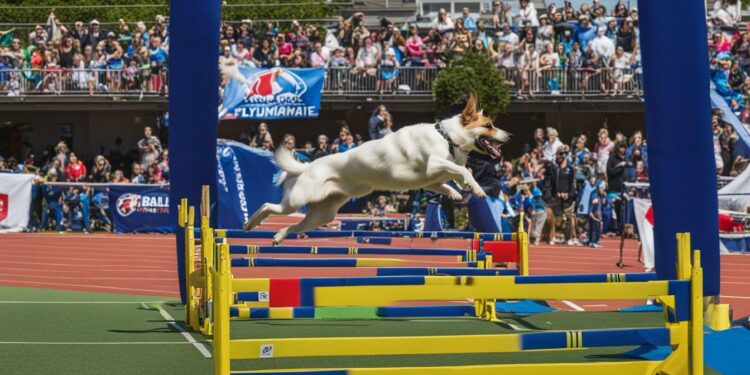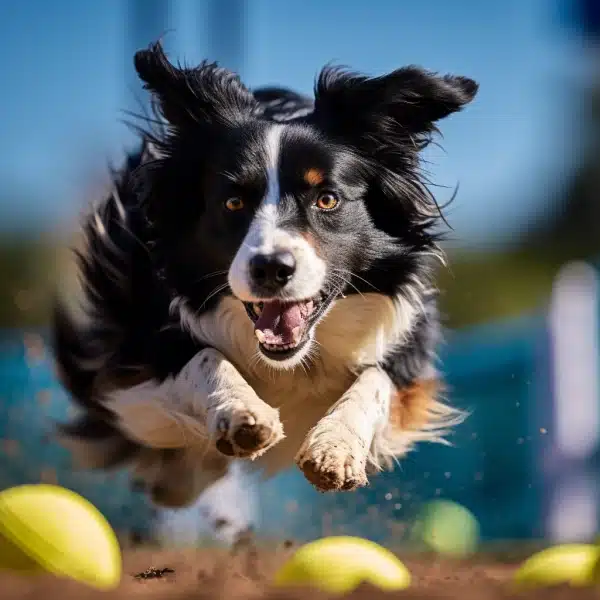Mastering Flyball Racing: Ultimate Guide For Dogs

Flyball Racing For Dogs: Welcome to the Ultimate Guide to Flyball Racing for Dogs! In this comprehensive guide, we will dive into the exciting world of flyball racing and provide you with everything you need to know to get started with this thrilling sport.
Flyball features dogs and handlers racing in relays. Dogs must leap over hurdles, collect a tennis ball from a box, and jump over hurdles again to finish.
Flyball is wonderful for high-energy dogs and has several benefits. It provides exercise, mental stimulation, socializing, and collaboration to deepen your bond with your dog.
Any dog can play flyball, big or small. Some breeds succeed in this sport due to their enthusiasm and intellect.
Flyball training includes teaching your dog to sit, recall, and jump over obstacles and retrieve a ball. Consult a vet before commencing flyball training to make sure your dog is ready.
Start training slowly and work on your dog’s fitness and stamina to avoid injuries. A firm foundation is vital to flyball racing success.
Join a local flyball club or attend classes from experienced trainers to get started. These events will teach you and your dog flyball skills and create a supportive community.
Flyball racing offers skill-level competitions. You and your dog can compete in teamwork and agility events whether you’re a novice or an expert.
The sport of flyball is enjoyable and rewarding for dogs and their owners. It’s an opportunity to bond with your dog while enjoying competition and watching your dog flourish in an exciting sport.
So prepare for this thrilling flyball racing adventure! This complete handbook gives you everything you need to make flyball a fantastic experience for you and your dog.
Stay tuned for the next section on flyball racing and how it’s played. Jump in!
What is Flyball Racing?

Flyball racing is a team sport that involves dogs and their handlers competing in a relay race. The objective is for the dogs to jump over hurdles, retrieve a tennis ball from a box, and then return over the hurdles to cross the finish line. It’s a thrilling and fast-paced activity that tests the speed, agility, and focus of both the dogs and their handlers.
In a typical flyball race, two teams of four dogs each compete against each other. The course consists of a line of four hurdles, followed by a flyball box that releases a tennis ball when the dog steps on a pressure-sensitive pad. The dogs must jump over the hurdles in a specific order, retrieve the ball, and return to the start/finish line as quickly as possible. The next dog in the team then takes its turn, repeating the same process until all four dogs have completed the course.
“Flyball racing is an exciting and dynamic sport that showcases the athleticism and intelligence of dogs. It’s a true test of their abilities and offers a great way for them to channel their energy and have fun.”
Flyball racing is not only a thrilling activity but also provides numerous benefits for dogs. It offers them a chance to engage in physical exercise, which is essential for their overall health and well-being. The jumping and sprinting involved in flyball help dogs build strength, endurance, and agility. Additionally, the mental stimulation of learning the course and executing the tasks keeps their minds sharp and focused.
Why should you consider flyball racing for your dog?
- Exercise: Flyball racing provides a high-intensity workout for dogs that helps burn off excess energy and keep them fit.
- Mental Stimulation: The sport challenges dogs to learn and execute complex tasks, keeping their minds engaged.
- Socialization: Flyball racing exposes dogs to other dogs and handlers, promoting social interaction and improving their social skills.
- Teamwork: Dogs and their handlers work together as a team, fostering a strong bond and enhancing communication between them.
Whether you have a high-energy breed or just want to engage your furry friend in an exciting and challenging activity, flyball racing is a fantastic option. It’s a sport that brings joy and fulfillment to both dogs and their owners, creating unforgettable moments and strengthening the human-canine bond.
| Benefits of Flyball Racing | Summary |
|---|---|
| Exercise | High-intensity workout that burns off excess energy and keeps dogs fit. |
| Mental Stimulation | Challenges dogs with complex tasks, keeping their minds engaged and sharp. |
| Socialization | Exposes dogs to other dogs and handlers, improving their social skills. |
| Teamwork | Fosters a strong bond between dogs and their handlers, enhancing communication. |
The Objective of Flyball Racing
The objective of flyball racing is for the dogs to jump over hurdles, retrieve a tennis ball from a box, and then return over the hurdles to cross the finish line. It is a fast-paced and exciting relay race that showcases the speed, agility, and teamwork of both the dogs and their handlers.
In flyball, teams typically consist of four dogs and their handlers. Each dog takes turns running down a straight course that is divided into four segments. At the start of the course, there are a series of hurdles that the dogs must jump over. Once they clear the hurdles, they reach a box that releases a tennis ball when the dog presses a spring-loaded pad. The dog then grabs the ball and races back over the hurdles to the finish line, where the next dog in the team takes over.
The objective is for the team to complete the course as quickly as possible, with each dog executing their part flawlessly. This requires a combination of speed, precision, and coordination between the dog and handler. The team that completes the course in the shortest amount of time without any mistakes is declared the winner.
Benefits of Flyball Racing for Dogs
Dogs gain from flyball racing by exercising, learning, socializing, and working together. Flyball features relay races between dogs and handlers. To finish, dogs must jump over hurdles, fetch a tennis ball from a box, then jump over hurdles again. High-energy activities like this keep canines active and healthy.
Flyball exercises dogs cognitively and physically. The sport needs dogs to obey directions, overcome barriers, and act quickly. This improves focus, agility, and problem-solving. Since dogs are constantly challenged and engaged, flyball can minimize boredom and destructive behavior.
| Benefits of Flyball Racing for Dogs |
|---|
| Physical exercise |
| Mental stimulation |
| Improved socialization |
| Opportunity to work as part of a team |
Dogs That Excel in Flyball Racing
While any dog can participate in flyball racing, certain breeds tend to excel due to their high energy levels and innate intelligence. These breeds are often characterized by their agility, speed, and enthusiasm for playing fetch. Popular breeds that are known to perform well in flyball racing include Border Collies, Australian Shepherds, Jack Russell Terriers, and Labrador Retrievers.
“Border Collies are highly intelligent and have a natural instinct for herding, making them quick learners in flyball training,” says Sarah Johnson, a flyball enthusiast and trainer. “They are incredibly agile and can easily navigate the hurdles while maintaining speed.”
Labrador Retrievers are another breed that excels in flyball racing. Their athleticism, strong retrieving instincts, and love for teamwork make them a natural fit for the sport. According to Johnson, “Labradors are incredibly dedicated and always give their all during flyball races. They have a great work ethic and are known for their ability to stay focused.”
| Breed | Characteristics |
|---|---|
| Border Collie | Highly intelligent, agile, quick learners |
| Australian Shepherd | Energetic, responsive, strong herding instincts |
| Jack Russell Terrier | Compact, high-energy, fearless |
| Labrador Retriever | Athletic, strong retrieving instincts, great work ethic |
While these breeds may have a natural inclination for flyball racing, it’s important to note that any dog can participate and enjoy the sport. Mixed breed dogs, often referred to as “All-Americans,” can also excel in flyball. What matters most is a dog’s enthusiasm, willingness to learn, and love for playing and interacting with their handler.
Training Tips for Flyball Racing:
- Start with basic obedience training to establish a strong foundation.
- Gradually introduce hurdles and teach your dog to jump over them.
- Focus on positive reinforcement and reward-based training methods.
- Practice ball retrieval by teaching your dog to fetch and release the ball on command.
- Gradually increase the speed and difficulty of training exercises to build endurance.
Remember, flyball racing is not just about competition—it’s about having fun and bonding with your furry friend. So, whether your dog is a purebred or a mixed breed, as long as they have the drive and enthusiasm, they can enjoy the thrill of flyball racing and create unforgettable memories together.
Training for Flyball Racing
Training for flyball racing requires a structured approach that includes teaching dogs basic obedience skills, agility training for jumping over hurdles, and practicing ball retrieval. It is important to start training gradually to prevent injuries and build endurance. Consulting with a veterinarian before starting flyball training and competition is essential to ensure that your dog is in good health and physically capable of participating in this high-energy sport.
“Flyball is a team sport that involves dogs and their handlers competing in a relay race,” says Dr. Sarah Stevens, a veterinarian and flyball enthusiast.
“The objective is for the dogs to jump over hurdles, retrieve a tennis ball from a box, and then return over the hurdles to cross the finish line. It requires speed, agility, and precise timing.”
To train your dog for flyball racing, you can join a local club or take classes with experienced trainers who can guide you through the process. These clubs and classes provide a supportive environment where you and your dog can learn from others who share the same passion. They offer training courses that cover everything from basic obedience to advanced agility techniques, helping you and your dog build the necessary skills and confidence for flyball racing.
| Training Tips for Flyball Racing |
|---|
| Start with basic obedience training to establish a strong foundation of communication and control with your dog. |
| Gradually introduce the concept of jumping over hurdles, starting with low heights and gradually increasing as your dog becomes more comfortable and confident. |
| Teach your dog to retrieve a ball and bring it back to you reliably. Practice ball retrieval exercises to improve speed and accuracy. |
| Focus on positive reinforcement and reward-based training methods to keep your dog motivated and engaged throughout the training process. |
Benefits of Training for Flyball Racing
In addition to the thrill and excitement of competing in flyball races, training for this sport offers numerous benefits for both dogs and their owners. Flyball provides a way for high-energy dogs to release their pent-up energy and stay physically fit. The mental stimulation of learning new skills and participating in a team sport can help prevent behavior problems caused by boredom or lack of mental stimulation.
Flyball also promotes socialization as dogs interact with other dogs and handlers during practice sessions and competitions. The teamwork involved in flyball racing strengthens the bond between dogs and their owners, fostering trust and cooperation. Moreover, the sense of accomplishment and achievement from successfully completing a flyball race can be incredibly rewarding for both dogs and their owners, creating a sense of pride and satisfaction.
By following a structured training approach, consulting with a veterinarian, and joining a local club or taking classes, you and your dog can embark on an exciting flyball racing journey. Whether you compete at a professional level or simply enjoy the camaraderie and fun of the sport, flyball offers a unique opportunity for dogs and their owners to engage in a challenging and fulfilling activity together.
Consultation with a Veterinarian
Before beginning flyball training with your dog, it is crucial to consult with a veterinarian to ensure they are physically fit to participate in this high-energy sport. Flyball is an intense activity that requires dogs to sprint, jump over hurdles, and make sudden turns. A veterinarian can assess your dog’s overall health and fitness level to determine if they are ready for the rigors of flyball racing.
During the consultation, the veterinarian will conduct a thorough examination of your dog, checking their heart, lungs, muscles, and joints. They may also recommend specific tests, such as blood work or X-rays, to identify any underlying health issues that could impact your dog’s ability to perform in flyball.
In addition to assessing physical fitness, the veterinarian can provide valuable advice and recommendations for preventing injuries during training and competition. They can guide you on proper warm-up exercises, cool-down routines, and injury prevention strategies. They can also discuss any dietary considerations to support your dog’s energy and stamina.
Remember, the well-being of your dog is of utmost importance. By consulting with a veterinarian before embarking on flyball training, you can ensure that your furry companion is in optimal health and ready to enjoy the excitement and fun of this thrilling sport.
Table: Flyball Fitness Assessment
| Physical Aspect | Assessment Criteria |
|---|---|
| Cardiovascular Fitness | The veterinarian will check your dog’s heart rate, rhythm, and any signs of fatigue during physical activity. |
| Muscle Strength | The veterinarian will assess your dog’s muscle tone and strength, particularly in the legs and core, which are crucial for flyball racing. |
| Joint Health | The veterinarian will examine your dog’s joints for any signs of inflammation, pain, or stiffness that could affect their agility and performance. |
| Overall Fitness | The veterinarian will consider your dog’s age, weight, and overall physical condition to determine their suitability for flyball racing. |
After the consultation, you will have a clearer understanding of your dog’s readiness for flyball training. If they are given the green light, you can proceed with confidence, knowing that you have taken the necessary steps to prioritize their well-being. Remember to continue consulting with your veterinarian throughout your dog’s flyball journey to ensure their continued health and success in this exhilarating sport.
Gradual Training and Conditioning
To avoid injuries and build endurance, it is essential to gradually train and condition your dog for flyball racing. Flyball is a high-energy sport that requires strength, agility, and stamina, so it’s important to prepare your dog physically and mentally for the demands of the game.
Start by incorporating regular exercise into your dog’s routine to build their endurance. Begin with shorter, low-impact activities like walking or jogging and gradually increase the intensity and duration of the workouts. This will help to strengthen their muscles and cardiovascular system, preparing them for the fast-paced nature of flyball racing.
Training Program
Implementing a structured training program is crucial to ensure your dog develops the necessary skills for flyball racing. Start with basic obedience training to establish a solid foundation of commands such as sit, stay, and recall. This will provide your dog with the necessary discipline and focus on the course.
Next, introduce your dog to the equipment used in flyball, such as hurdles and the ball box. Take it slowly, allowing them to become familiar with each element and gradually increase the difficulty level. Use positive reinforcement techniques, such as treats and praise, to encourage and motivate your dog throughout the training process.
Consult with a Veterinarian
Prior to starting any training program, it’s essential to consult with a veterinarian. They can assess your dog’s overall health and fitness level, ensuring they are in prime condition for flyball racing. Additionally, your vet can provide guidance on injury prevention, proper conditioning techniques, and any specific considerations based on your dog’s breed or age.
Joining a Local Flyball Club or Taking Classes
Getting started in flyball racing is as simple as joining a local flyball club or enrolling in classes specifically designed for this exciting sport. Flyball clubs provide a supportive and encouraging environment where you and your dog can learn and develop the skills needed to excel in flyball racing. These clubs often have experienced trainers who can guide you through the training process and help you and your dog reach your full potential.
When looking for a local flyball club, consider factors such as proximity to your home, training schedules, and the club’s reputation. Visiting and observing a few sessions can also give you a good idea of the club’s training methods and if they align with your goals. Many clubs also offer introductory classes for beginners, where you can learn the basics of flyball and see if it’s the right fit for you and your dog.
Another option is to enroll in flyball classes specifically tailored to beginners. These classes are typically taught by experienced instructors who can provide step-by-step guidance and ensure that both you and your dog are learning at a suitable pace. Classes often cover topics such as basic obedience skills, hurdle jumping techniques, ball retrieval, and relay race strategies. Taking classes can be a great way to meet other flyball enthusiasts and build a supportive network within the flyball community.
Table: Flyball Clubs in Your Area
| Name | Location | Contact |
|---|---|---|
| Fast Paws Flyball Club | 123 Main Street | [email protected] |
| Speedy Retrievers Flyball Team | 456 Elm Avenue | [email protected] |
| High-Flyers Canine Racing Group | 789 Oak Lane | [email protected] |
Joining a local flyball club or taking classes not only provides you and your dog with the necessary skills for flyball racing but also opens the door to a vibrant and supportive community. You’ll be able to participate in training sessions, attend competitions, and connect with like-minded individuals who share your passion for flyball. So, don’t wait any longer! Take the first step in your flyball journey by joining a local club or signing up for classes today.
Opportunities for Competition
Flyball racing offers a wide range of competition opportunities for participants at different skill levels, allowing you and your dog to progress in the sport. Whether you’re just starting out or have been competing for years, there are events and tournaments that cater to every level of experience and ambition.
One of the most popular types of flyball competition is the local tournament. These events are held regularly and provide a great opportunity for beginners to get a taste of the sport. Local tournaments are often more relaxed and focused on building skills and confidence, making them a perfect starting point for new teams.
For those looking to take their flyball skills to the next level, regional and national competitions offer a greater challenge. These events attract top teams from across the country and showcase the highest level of competition. Participating in regional and national tournaments can be a thrilling experience, as you compete against some of the best flyball teams in the country.
If you and your dog excel in the sport and are looking for ultimate recognition, international flyball competitions are where you want to be. These tournaments bring together teams from different countries, creating a global stage for flyball racing. Competing on an international level not only represents a significant achievement but also provides the opportunity to make lifelong connections with fellow flyball enthusiasts from around the world.
Upcoming Flyball Tournaments
| Date | Location | Type of Tournament |
|---|---|---|
| May 15-16, 2022 | Chicago, IL | Regional Tournament |
| June 5-6, 2022 | Los Angeles, CA | National Championship |
| August 20-22, 2022 | London, UK | International Tournament |
So whether you’re aiming to dip your paws into the world of flyball or have your sights set on international glory, there’s a competition out there waiting for you and your dog. Embrace the challenge, push your limits, and enjoy the thrill of flyball racing!
The Fun and Rewards of Flyball Racing

Flyball racing is fascinating for dogs and an enjoyable bonding activity for owners. This high-energy sport combines exercise, mental stimulation, and collaboration, making it excellent for dogs and their owners.
Relay races are thrilling in flyball. You’ll feel proud and excited as your dog jumps hurdles, retrieves a tennis ball, and sprints back to the finish. It’s an exciting sport that highlights dogs’ athleticism and agility.
But competition isn’t everything. Flyball also strengthens dog-owner bonds. Trust and communication are built during obedience and flyball training. Working together will bond you and your pet beyond the racecourse.
| Benefits of Flyball Racing for Dogs: |
|---|
| Exercise and Physical Fitness |
| Mental Stimulation |
| Socialization Opportunities |
| Teamwork and Bonding |
Flyball racing helps dogs burn energy and get fit. The hard sprinting, jumping, and ball retrieval increase muscle, endurance, and cardiovascular fitness. Regular flyball can improve your dog’s health.
Flyball challenges dogs to think rapidly and make split-second judgments during races. This mental challenge keeps them engaged and prevents boredom, releasing their intelligence.
Flyball racing also promotes socialization. In a supervised atmosphere, dogs can socialize and gain confidence with other canine athletes. It introduces students to diverse breeds, personalities, and training methods.
Congratulations! You’ve reached the end of the Ultimate Guide to Flyball Racing for Dogs.
Now it’s time to take the knowledge, tactics, and tips you’ve gained and start enjoying the exhilarating world of flyball racing with your furry companion. Flyball is a team sport that provides not only physical exercise but also mental stimulation, socialization, and teamwork for both you and your dog.
Whether your dog is a high-energy breed or not, any dog can participate in flyball and have a great time. The sport involves jumping over hurdles, retrieving a tennis ball from a box, and crossing the finish line. It’s a thrilling activity that will keep your dog engaged and active.
Remember, training is key to success in flyball. Start by teaching your dog basic obedience skills and gradually introduce them to jumping hurdles and retrieving balls. Consulting with a veterinarian before starting training is important to ensure your dog is in good health and fit for the sport. Take your time and condition your dog gradually to prevent injuries and build endurance.
To get started, consider joining a local flyball club or taking classes. Learning from experienced handlers and practicing with other dogs will not only enhance your dog’s skills but also create a sense of community. There are also various opportunities for competition in flyball racing at different levels, so you can test your skills and see how you and your dog measure up.
In conclusion, flyball racing is a fun and rewarding activity that offers numerous benefits for you and your dog. It provides exercise, mental stimulation, socialization, and teamwork. So, grab a tennis ball, get your dog’s tail wagging, and dive into the exciting world of flyball racing!
FAQ
Q: What is flyball racing?
A: Flyball racing is a team sport that involves dogs and their handlers competing in a relay race. The objective is for the dogs to jump over hurdles, retrieve a tennis ball from a box, and then return over the hurdles to cross the finish line.
Q: What are the benefits of flyball racing for dogs?
A: Flyball racing provides exercise, mental stimulation, socialization, and teamwork for dogs. It is a great activity for high-energy dogs and helps them release their energy in a fun and controlled manner.
Q: Can any dog play flyball?
A: Yes, any dog can play flyball. While certain breeds may excel due to their energy levels and intelligence, flyball is open to all dogs regardless of breed or size.
Q: How do I train my dog for flyball?
A: Training for flyball involves teaching basic obedience skills, jumping over hurdles, and ball retrieval. It is important to start training gradually and consult with a veterinarian before beginning flyball training.
Q: How can I get started in flyball?
A: You can get started in flyball by joining a local club or taking classes. These organizations provide guidance, support, and opportunities for competition at different levels.





